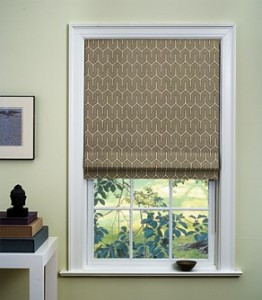Drapes, along with their country cousins, curtains, are probably the most common and traditional form of window covering. Typically constructed of fabric, drapes can be as simple as a single panel hung from clip rings to an elaborate multi-layer affair. Drapes are available “off the rack” for standard sized windows, or can be custom made to order. They are also an easy DIY project.
Why to choose drapes: Drapes soften the hard edges of a space, filter light, and help to absorb sound. They have the widest range of options of any window treatment, in terms of both look and cost. They are relatively easy to install. Drapes can be a focal point of a space, and provide the opportunity to bring color and pattern into a room.
Why NOT to choose drapes: Drapes are vulnerable to fading, pet damage, and attacks from 3-year-olds wielding scissors. (Yep, true story. I will tell you someday, after a strong beverage or two.)
2. SHADES
Photos courtesy of The Shade Store
The “window shades” category actually covers a range of different products, including roman shades, cellular shades, and roller shades (see examples above.) The commonality is that shades sit within or just in front of the window frame, and have some form of operating mechanism for raising and lowering them. Shades come in all kinds of different materials, including fabric, wood, natural fibers, and synthetics.
Why to choose shades: If you have interesting windows and window moldings, shades are a great way to show off that feature of your home. Generally speaking, shades lend themselves more to a contemporary or transitional style space. They are less fussy than drapes, and can be easily raised and lowered to allow in light or provide privacy as needed. Some roman and most cellular shades have the added advantage of providing insulating benefits to your home.
Why NOT to choose shades: “Off the rack” is not really an option for most shades – you’ll want to get them custom fitted to your windows. Good quality shades (with the exception maybe of the simplest roller shade) are not the cheapest option out there, and extras like blackout liners, edge banding and sophisticated control mechanisms quickly jack up the price. Washability may also be a challenge – a regular vacuuming will help keep them dust-free, but more serious stains might require a trip to the dry cleaner. Fabric protection is a great idea for fabric shades.
3. BLINDS
Blinds are (typically) 1″ wide horizontal slats made of metal, vinyl or wood and bound together with string. Like shades, blinds sit within or just in front of the window frame. They are adjustable up and down, and can also be twisted open-closed to control privacy and light filtration in a room. Vertical blinds are also part of the blinds family, but I think it’s safe to say, they have fallen out of favor for residential use in recent years. They do connote a more commercial look.
Why to choose blinds: Because they’re so adjustable, blinds offer maximum control of light-view-privacy. Aluminum blinds are better suited to contemporary spaces, while wood blinds could be succesful in a more traditional interior. Good quality blinds are very durable, stain resistant, and will last a long time.
Why NOT to choose blinds: One word: dust. All of that slatted surface area will collect dust and be a nuisance to keep clean. Like shades, blinds optimally should be custom cut to fit your windows. Aluminum or vinyl blinds suffer from a “cheap” connotation, and while wood blinds look nice they are pricey. Also my personal opinion: if you have divided window panes (mullions), I feel that this looks awkward showing behind slatted blinds. I think drapes or shades are a better choice for divided windows.
4. PLANTATION SHUTTERS
Plantation shutters are slatted louvers that sit within a frame and are attached inside or just on top of your window frame. They’re typically made of wood or wood composite materials, and have a tilt-bar mechanism that allows you to control the amount and direction of light entering the space.
Why to choose plantation shutters: They add a strong architectural element that most complements a traditional or transitional interior. Plantation shutters are durable and longer lasting than most other window coverings. Similar to blinds, they allow full control of light and privacy. A significant advantage is that shutters can be custom fitted to rounded or other irregularly shaped windows.
Why NOT to choose plantation shutters: They offer a lot of the same advantages of blinds but typically at a higher price. Also similar to blinds, shutters have all of those louvered surfaces that will collect dust and require upkeep. Shutters may not be the best choice for windows with great views, as they will block the view unless fully opened and swung out from the window.
After reviewing all of the major categories of window coverings, I’d be remiss if I didn’t mention one other option: no window covering at all! If privacy and light control aren’t a major concern, and if you have architecturally interesting windows and/or a great view, you may wish to leave them un-adorned. How’s that for a budget-friendly option?
I hope this primer on window treatments has been helpful. Happy window shopping!







